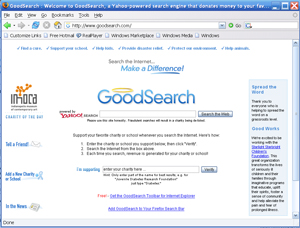Loyalty schemes as strategically deployed programmes to aid to Patient Retention
 Loyalty schemes are becoming more and more prevalent in the retail world and indeed beyond to the service industry. These schemes are not really deployed in our industry to any real extent. I think an introduction of a loyalty scheme can and will help your business in the long term. The mantra in our business, particularly at present, although in some quarters it is nothing new, is Patient Retention. We all know that in order to survive in the current economic climate we need to retain our Patients and in doing so we will see a growth in new business through customer referral. I have written before here along these themes and I am constantly thinking about tactical applications that will encourage that strategic goal.
Loyalty schemes are becoming more and more prevalent in the retail world and indeed beyond to the service industry. These schemes are not really deployed in our industry to any real extent. I think an introduction of a loyalty scheme can and will help your business in the long term. The mantra in our business, particularly at present, although in some quarters it is nothing new, is Patient Retention. We all know that in order to survive in the current economic climate we need to retain our Patients and in doing so we will see a growth in new business through customer referral. I have written before here along these themes and I am constantly thinking about tactical applications that will encourage that strategic goal.
In my day to day work in Widex Ireland I am on hand to advise and support our accounts with business and marketing ideas to assist them with their business. Here at Widex and I mean Widex internationally, we are committed to supporting our customers to grow and prosper. This is not all altruistic of course, it is grounded in the belief that if our customers prosper through our support, so shall we. Their success is by extension our success. This attitude is enshrined within Widex and has been since the inception of the company, I think we as a company have become famous for forging long standing business relationships with Partners as opposed to just selling to Customers.
Enough of the love fest already, I just give it as background as to why we are constantly thinking about ways for you, our customers to succeed, that and the hope that Mike (the big Gaffer) says, this guys a genius. Stop laughing Miller it could happen! Back to the point, Loyalty Schemes, so how will we introduce it and what will we offer. Also, what do we expect back from the scheme, the scheme, no matter its extent will involve some investment, whether that be time resources or money. In order to assess some of these questions we first have to understand what a loyalty scheme is and how it applies to our business.
So a loyalty scheme is defined as the following:
- a scheme to keep the business of existing customers, e.g. by special
discounts for loyalty card holders
So in essence it is a simple concept, in application is where it gets interesting. The immediate questions that are raised for me are:
- What Customers?
- What discounts?
- On what products?
- Loyalty Card? Now you are having a giggle right?
Ok, lets have a look at the preceding:
What customers? Hell allllll of them, even people who aren't your customers. When you start a good loyalty club, advertise it, anyone can join and avail of the discounts on the products or services you define. If they want either the products or indeed the services if you include any, they are either hearing instrument users or they know somebody who is. If you didn't sell them the last set of instruments lets try and make sure you sell them the next set of hearing instruments. So start your loyalty club and advertise its advent, advertise it as open to anybody on sign up. Include a reference to it in all your advertising, web, news media, leaflets, practice brochures etc, oh and it is a perfect opportunity to send a meaningful communication of real value(I talk about  these a lot) to your existing customers.
these a lot) to your existing customers.
What discounts? That is for you to decide, but they have to be meaningful and of value to your customers and more importantly to people who are not your customers yet. You need to look at it from a purely economic point of view, the cut in margin can be made up in volume sales. Another key thought here is that attracts new customers and helps to retain old ones is a real cheap lead. How much do you think it costs you via traditional marketing to generate a lead? If all it costs you here is a cut in margin and a few pence for mailing and loyalty cards, that is a pretty cheap lead.
 On what products? Okay, this is where it becomes an interesting tactical exercise, you need to ask yourself what do I wish to achieve with this strategy. You also need to ask yourself what do my customers want and what would they value from me? I think there is actually a meeting of needs here, it would be nice for most businesses to increase revenue from regular purchase ancillary products. The core regular purchase ancillary products in our business are batteries and clean and care products, clean and care products are something that I am sure we would all like to encourage as they bolster instrument reliability and reduce failure and service costs. So for both us and the Patient the purchase of clean and care supplies are a win win. So encourage the sale through discounted products and do so in a way that brings benefit to you through offering discounts through a loyalty club. You can also consider in the medium to long term offering discounts on new sets of hearing instruments, again perhaps you are reducing margins, but we all give discounts to returning Patients. A loyalty scheme formalises this and also removes the need to discuss discount because you have set it.
On what products? Okay, this is where it becomes an interesting tactical exercise, you need to ask yourself what do I wish to achieve with this strategy. You also need to ask yourself what do my customers want and what would they value from me? I think there is actually a meeting of needs here, it would be nice for most businesses to increase revenue from regular purchase ancillary products. The core regular purchase ancillary products in our business are batteries and clean and care products, clean and care products are something that I am sure we would all like to encourage as they bolster instrument reliability and reduce failure and service costs. So for both us and the Patient the purchase of clean and care supplies are a win win. So encourage the sale through discounted products and do so in a way that brings benefit to you through offering discounts through a loyalty club. You can also consider in the medium to long term offering discounts on new sets of hearing instruments, again perhaps you are reducing margins, but we all give discounts to returning Patients. A loyalty scheme formalises this and also removes the need to discuss discount because you have set it.
Loyalty Card? Yes please, nice shiny pieces of plastic woohoooooo. I love em, makes me feel all growed up! Sorry I digress, a good quality loyalty card is in the scheme of things quite cheap to have printed, then individualizing it is easy with some of the desktop printing solutions designed for this purpose. Get a well designed loyalty card printed up, even better if your till system scans codes, you can entry the data on it and the production and scan of the card at point of sale can automatically apportion discount. In this manner you can also capture ongoing data pertaining to purchasing and design and customise individual offers to your Patients. Of course none of this works as well if you do not have good CRM systems coupled with good point of sales systems. But don't let that put you off, it can be done manually, just design your CRM in order that you can record purchases on it in a way that you can search and quantify. The only way to manage and grow your business is by knowing all the data.
Please feel free to comment and tell me why I am wrong! J










